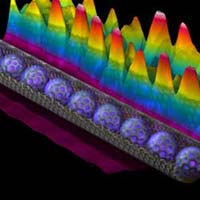Nanotube ’Peapods’ Exhibit Surprising Electronic Properties

Image: D. Hornbaker and A. Yazdani
In yet another small step toward building nanoscale devices, scientists have determined that nanotube peapods — minute straws of carbon filled with spherical carbon molecules known as buckyballs — have tunable electronic properties. Published online by the journal Science,the findings suggest that stuffing the straws provides greater control over the electronic states of single-walled carbon nanotubes (SWNT).
Using a low-temperature scanning tunneling microscope, Ali Yazdani of the University of Illinois at Urbana-Champaign and colleagues imaged the physical structure of individual peapods (right). They mapped the motion of electrons within the pipes and, as Yazdani explains, showed “that an ordered array of encapsulated molecules can be used to engineer electron motion inside nanotubes in a predictable way.” Though the harbored buckyballs modify the electronic properties of the nanotube, the atomic structure of the straw remains unchanged.
The researchers also utilized the microscope to move the buckyballs, which allowed them to compare the same section of a SWNT when it was filled and unfilled. “The encapsulated balls have a much stronger effect on the electronic structure of the tube than we had expected,” says study co-author Eugene Mele of the University of Pennsylvania. Indeed, the authors conclude that their calculation not only shows how a peapod’s electronic properties differ from those of its constituent parts, “it also provides possible design rules for proposing hybrid structures having a specific type of electronic functionality.”
Media Contact
More Information:
http://www.sciam.com/news/010402/1.htmlAll latest news from the category: Materials Sciences
Materials management deals with the research, development, manufacturing and processing of raw and industrial materials. Key aspects here are biological and medical issues, which play an increasingly important role in this field.
innovations-report offers in-depth articles related to the development and application of materials and the structure and properties of new materials.
Newest articles

Superradiant atoms could push the boundaries of how precisely time can be measured
Superradiant atoms can help us measure time more precisely than ever. In a new study, researchers from the University of Copenhagen present a new method for measuring the time interval,…

Ion thermoelectric conversion devices for near room temperature
The electrode sheet of the thermoelectric device consists of ionic hydrogel, which is sandwiched between the electrodes to form, and the Prussian blue on the electrode undergoes a redox reaction…

Zap Energy achieves 37-million-degree temperatures in a compact device
New publication reports record electron temperatures for a small-scale, sheared-flow-stabilized Z-pinch fusion device. In the nine decades since humans first produced fusion reactions, only a few fusion technologies have demonstrated…





















